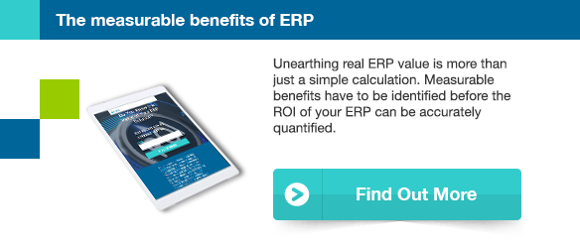Yesterday afternoon I had a phone call from a relatively new customer, James Briggs, who ‘went live’ with SYSPRO a few months ago. “Right,” the CFO said, “we need you to come in and talk to us about how we can really start to use SYSPRO now.”
James Briggs recognized that the project didn’t end when they started using SYSPRO, rather this was just the first step in generating a return on investment. James Briggs is a growing company, so they need to make sure they can utilize the features and functions in SYSPRO to increase their productivity, enabling them to generate more revenue from the same resources.
James Briggs need to understand where their growth potential lies, matching external market data with their own internal sales trend data. Finally, they need to understand the cost structure of each product, to ensure that the choices they make maximize their margins.
Simplifying Processes
Many organizations go live with a very similar process to what they had before. Changing the system and the process can be too much at once for staff and can lead to more business disruption than a business can handle, particularly a growing business.
Until a new system is embedded, sometimes the best way to run a process isn’t clear. Employees trying to design a new process are naturally constrained by the knowledge that they already have about ‘the way we do things’.
Returning to the processes after go live is a good way to increase efficiency. Ask the ERP users what they think they could do better? Are there any processes that seem to take longer in the new ERP system? Are there improvements they would like to see, and how do they think they can be achieved?
Review the system with your ERP vendor. Which processes can be automated? Where can you use workflow? Can you integrate to your Manufacturing Execution Systems (MES)? Can you implement more EDI with your customers and automatically generate consignments for your carriers?
Gaining Insight
The implementation of an ERP system is not just about generating transactional data and facilitating efficient processes. Businesses have to be able to get the information back out. Look at your reporting packs, do they give you the information you need? Are they out of date before they are finalized? Can you only see information at the end of the month? Do you have to be at your desk to see it?
Review the many mobile options available now to view data, like SYSPRO Espresso, showing you exactly how your business is performing at any point in time. Speak to your ERP vendor about changing your printed reports to dashboards which give you the ability to slice and dice data and roll these dashboards out widely so all users see the impact of their decisions.
Finally, engage with system professionals about the opportunities for big data. What analytics can you derive from your data and how can it help your business grow? Look for trends and patterns that aren’t yet obvious in the business to understand where you can gain competitive advantage in the market place.
Cost Control
Understanding demand is an important element of creating a targeted growth strategy, but the cost structure must also be understood on a detailed level in order to secure already tight margins.
The first step is ensuring all the data already in the system is accurate: operation times, waiting times between jobs, moving items around the shop floor all have an impact on costs, as well as the usual labor, overhead and material figures.
Build robust cost analysis models so that you can quickly judge the impact on the bottom line of producing more or less or a certain product line, or the consequences of a renegotiated supplier contract or a change in a commodity price.
Look at your working capital costs. How much have you tied up in inventory, what could you do with that additional cash – what investments could you make and what return would they generate? Could a module such as SYSPRO Inventory Optimization help to better forecast and plan inventory? Could debtors be better managed with slicker credit management processes implemented and automated through SYSPRO? Is there scope for getting better control over your supplier payment runs?
Achieving Return on Investment
There are many ways to achieve a substantial return on investment from your ERP system but you don’t get the return without the investment. The first stage is securing a solid ERP platform, ensuring you have an up-to-date product that can take you where you want to go. But you have to follow through with the second stage and actually realize the returns.
- Examine your processes, automate and integrate, simplify
- Make your data work for you, gain insight
- Get your costs understood and under control
And once you have finished, start on the next round. Continually improve your business, to fuel growth and secure your return on investment.








